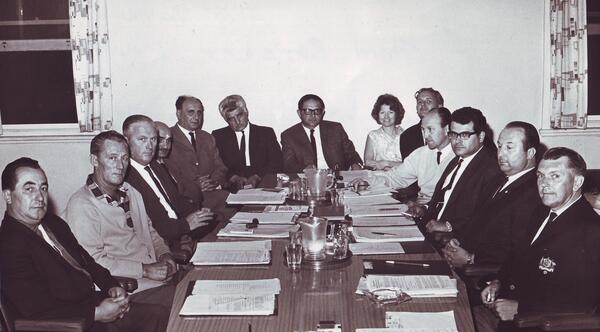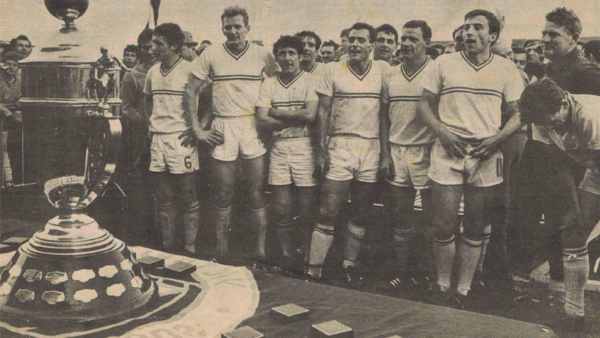The birth of the Victorian Soccer Federation
Divisions remained and the Victorian State League clubs sent a group led by Theo Marmaras of South Melbourne Hellas on a fact-finding mission to the other states. Though there was considerable division in Victoria, Marmaras’s group led the drive to join the new Australian Soccer Federation when it was set up in November 1961. For the next several months there was a popularity contest in Victoria between the Federation and the Association, with the former coming out on top after its games at Olympic Park attracted much bigger crowds than VASFA’s at the Melbourne Showgrounds. Eventually, after the matter was taken to court and the judge encouraged the two contending parties to settle their differences, this is what happened and the Victorian Soccer Federation succeeded the VASFA in February 1962. The new season began in March with a record 202 football teams taking part in Melbourne competition—108 seniors and 96 juniors. South Melbourne Hellas would win the first championship under the VSF banner, just two years after Hellenic, Yarra Park and South Melbourne United amalgamated to form the club in 1960.

JUST claimed their second championship in 1963, with a young Rale Rasic, Frank Micic, Billy Rice and Tommy Stankovic forming the backbone of the team which would claim the league-cup double, with a thrilling 4-2 win over Polonia, sighted by Micic as the greatest club match ever played in Victoria. The take-over over by the Victorian Soccer Federation did not solve all the problems of Victorian or Australian soccer. In 1963 FIFA refused to readmit Australia until fines of £48,000 were paid.
The structure set up in those years reflected the importance of the clubs and the states, and its relatively small franchise encouraged horse trading and personality politics. But the focus and the costs of the game were to shift in the next decade to the national level as Australia began to try to qualify for the World Cup and soccer instituted the first national league of any of the codes of football in 1977. After unsuccessful campaigns in 1965 and 1969, Australia finally reached the World Cup for the first time in West Germany in 1974, when Rale Rasic, former coach of Footscray JUST, led a squad which included several Victorian players—Jack Reilly, Jimmy Rooney, Peter Ollerton, Jimmy Mackay, Jim Milisavljevic and Branko Buljevic.
Victorian clubs over the years have done very well in inter-club national competitions. In 1960 JUST won the first national Ampol Cup in a round robin with teams from Queensland, New South Wales and South Australia. Slavia, George Cross and Melbourne Hungaria won the Australia Cup in 1963, 1964 and 1967 respectively. In 1971 Croatia Melbourne won an interstate Ampol Cup against New South Wales opposition and South Melbourne Hellas beat St George from Sydney in an unofficial interstate decider in 1976.

In 1964 relations between Association football and the Australian Rules game were improved, if only briefly, by a challenge match between Slavia, winner of the Dockerty Cup that year, and a team of footy players including Jack Dyer, Ron Barassi, Ted Whitten, Kevin Murray, Des Tuddenham and Gordon Collis. The Slavia team had goalkeeper Ray Barotajs, Peter Aldis, John Auchie and Hammy McMeechan. Expecting to steamroller the Slavia boys, the footy players were taught a lesson in an eight-nil drubbing. Considerable sums were raised for charity and a little respect was gained for the skills and technique of the round-ball players.
From the 1960s to the 1980s there was increasing concern about off-field violence associated with the game. This was not just an Australian phenomenon and indeed levels of spectator misbehaviour in this country were lower than overseas. Much of the media focus was on supposed ‘political’ differences imported by European migrants, but in many cases incidents had local and contingent origins. Several clubs were suspended for failure to control their players and spectators, including Geelong and George Cross, but the expulsion of Croatia in 1972, after an incident in a State League match against Hakoah, had a salutary effect.
On the pitch, the battle for supremacy was largely won by South Melbourne Hellas, who followed their maiden win in 1962 with a hat-trick of championships between 1964 and 1966. Another three would follow in 1972, 1974 and 1976, making it seven wins in fifteen seasons and ensuring they assumed the mantle from Juventus as the power club in Victorian football. JUST followed up their league-cup double in 1963 with wins as Footscray JUST in 1969, 1971 and 1973. Other clubs to have claimed league honours included Melbourne Hungaria (1967), Croatia (1968), Juventus (1970) and Fitzroy United Alexander (1975).
